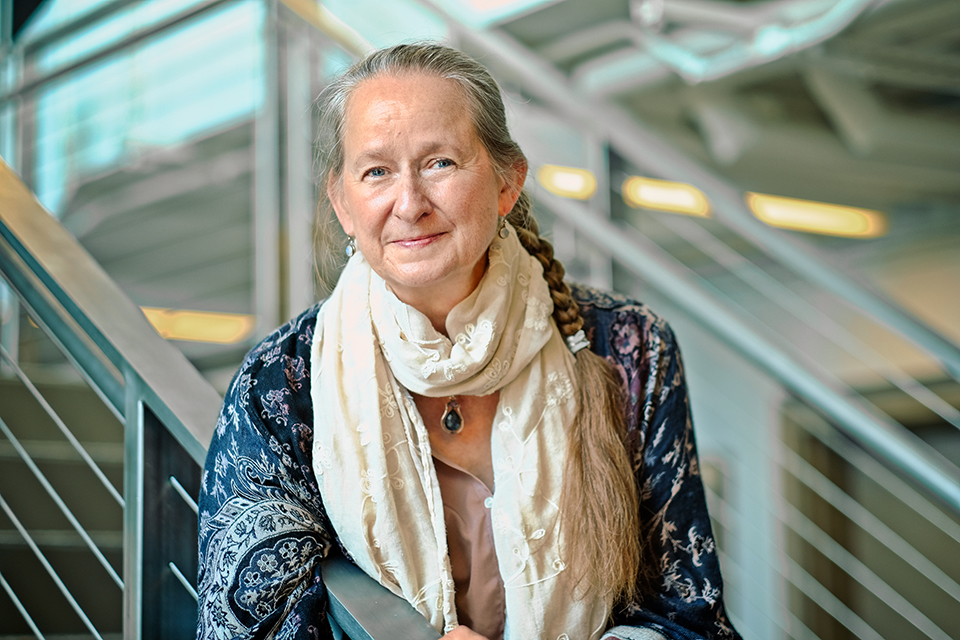4 ways to leverage your creative network
Susan Crabtree, an author and an award-winning scenic designer with three decades of teaching experience, has served as Director of Scenic Art in the UNCSA School of Design and Production since August 2018. She has co-authored three editions of “Scenic Arts for the Theatre,” a widely used textbook, and is collaborating on a book about scene painting technique and pedagogy. She has received several awards, including three for scenic design from the Kennedy Center for the Performing Arts, and a Best Scenic Design of the Season Award from the Colorado Theatre Guild.
Crabtree’s credentials, then, are impeccable. And under any circumstances, they would have made her a serious contender for her current appointment, which she calls her dream job. But she acknowledges that the effective ways she has used her creative network over the years has also played a pivotal role in landing her at UNCSA.

Susan Crabtree is Director of Scenic Art in the School of Design & Production.
She and Howard Jones, her predecessor at UNCSA, had interacted professionally several times since the early 1980s. He was one of her textbook’s readers, she taught at two arts-intensive weekends at UNCSA, and they made a joint presentation at The United States Institute for Theatre Technology, Inc. (USITT). Crabtree told Jones she wanted to work at UNCSA. They kept in touch, and when Jones retired last year, he made certain to inform her the department would be accepting applications for a new Director of Scenic Art.
Below, Crabtree shares four other ways that scenic designers and other artists can make the most of their creative networks during various stages of their careers.
1. Reach out to your tribe, aka your college classmates.
Although you should always try to mix things up by working with new people with new ideas, some of the strongest collaborative relationships in your creative network are forged in college, and there’s nothing wrong with reaching back out to people who’ve joined what Christine Jones, the Tony Award-winning scenic designer, calls your tribe.
People in your tribe are indispensable members of your creative network. You’re philosophically copasetic with them. You understand what each other's motivations are. You understand what principles of design and elements of art are important to one another. You have grown together as artists, and you have a collaborative shorthand.
When you are comfortable with members of your creative network you all become good at monitoring and editing each other. You know when to say: “It’s that old thing again. We’re falling back on that old thing again. Let’s reach for something new."
2. Your creative network is like a big brain. Tap into it.
If you want to grow, if you want to evolve as an artist and as a professional, then having curiosity about what other people in your creative network are doing is essential. I regularly reach out to other scenic designers and artists to learn how they solved problems or mastered techniques and skills. I call this part of my creative network The Big Brain. You can keep poking along with your little brain, all on your own, or you can reach out to The Big Brain—which makes you that much smarter and that much better at what you do.
Remember, too, that good ideas can come from anywhere and anyone. When I’m designing a set, for example, the sound designer might have great ideas about what form and format the set needs to be in for that production at that time in that place. So, I take her views into account, as along with those of, say, a lighting designer, a technical director and a carpenter.
3. Use your creative network strategically.
We all have to eat and pay the rent. So, there’s nothing wrong with using your creative network to find a job. When a source of long-term employment dried up for me, I worked the floor of a recent USITT conference hard. I walked around to all my colleagues and said, “I’m looking for a job.” I found a job at the University of Arkansas, where I worked before UNCSA.
When I consider what a creative network can do for me, I think also in terms of artistic growth... For me, the main thing is to do good work and be involved in good projects: projects that are important, projects that are telling a story, projects that are making a difference in terms of helping an audience come to terms with their point of view about a given subject.
Susan Crabtree
That said, when I consider what a creative network can do for me, I think also in terms of artistic growth—not necessarily just monetary rewards or the advancement of my career. For me, the main thing is to do good work and be involved in good projects: projects that are important, projects that are telling a story, projects that are making a difference in terms of helping an audience come to terms with their point of view about a given subject. And then, that generally—not always, but generally—leads to better jobs, and also fulfilling jobs.
4. Be. Pleasant. Always.
Your creative network is your most important asset. So, make sure that you make it easy for people to work with you, that you are a pleasant and reliable person to work with, that you make your collaborators’ lives easier, that you're not the kind of person that holds the process up.
I tell my students, “If you make your employer’s life easier, if people say, ‘Oh, thank God that person’s here,’ when you walk through the door, you will get a strong recommendation and you will get hired again. It is just a given. Sure, you have to do a good job, but being pleasant and reliable is just as important.
Build your creative network.
December 17, 2018


